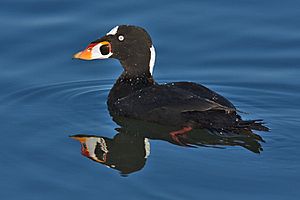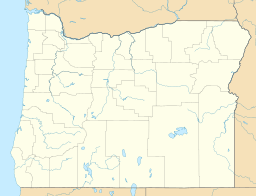Suttle Lake (Oregon) facts for kids
Quick facts for kids Suttle Lake |
|
|---|---|

Suttle Lake viewed from Link Creek camp
|
|
| Location | Deschutes National Forest, Oregon |
| Coordinates | 44°25′19″N 121°44′24″W / 44.422°N 121.740°W |
| Type | Natural |
| Primary inflows | Link Creek |
| Primary outflows | Lake Creek |
| Catchment area | 21.3 square miles (55 km2) |
| Max. length | 1.4 mi (2.3 km) |
| Max. width | 0.4 mi (0.64 km) |
| Surface area | 253 acres (102 ha) |
| Average depth | 44 ft (13 m) |
| Max. depth | 75 ft (23 m) |
| Shore length1 | 3.6 mi (5.8 km) |
| Surface elevation | 3,438 ft (1,048 m) |
| 1 Shore length is not a well-defined measure. | |
Suttle Lake is a beautiful natural lake in central Oregon, United States. It's located high up in the Cascade Range mountains. The lake covers about 253 acres (1.02 square kilometers).
Suttle Lake was named after a pioneer named John Settle. But when it was officially recorded, his name was accidentally spelled "Suttle." Today, the lake is part of the Deschutes National Forest. It's a very popular spot for outdoor fun in central Oregon. You can find three big campgrounds and two day-use areas along the lake's south shore. The Oregon Department of Fish and Wildlife regularly adds rainbow trout to the lake for fishing.
Contents
A Look Back: Suttle Lake's History
Early Days: Native Americans at Suttle Lake
For thousands of years, Native Americans lived around Suttle Lake. They were here long before the first European explorers arrived. These groups used trails over Santiam Pass to travel between the Willamette Valley and central Oregon. Suttle Lake was a perfect place for them to camp, fish, and gather berries. It was just east of the mountain summit.
How Suttle Lake Got Its Name
Suttle Lake is named after John Settle. He was an American pioneer who lived in Lebanon, Oregon. John Settle helped build the Santiam Wagon Road in the 1860s. This was a very important road for travel back then. In 1866, John Settle found the lake while on a hunting trip. Even though the lake is named for him, his last name was misspelled as "Suttle" when it was officially recorded.
Suttle Lake Becomes a Protected Area
In 1898, Suttle Lake became part of the Cascade Range Forest Reserve. This meant the area was protected. Later, it became part of the Cascade National Forest. In 1908, the area was moved to the new Deschutes National Forest.
Developing the Lake for Visitors
In the 1920s, the United States Forest Service allowed some buildings at the lake. They gave permits for a summer camp, a lodge, and small cabins. The Forest Service also built three public campgrounds. Today, the Sisters Ranger District manages Suttle Lake and the surrounding forest. The Oregon Department of Fish and Wildlife takes care of the lake's fish.
Suttle Lake's Water System
Where Suttle Lake Gets Its Water
Suttle Lake is on the east side of the Cascade Range in central Oregon. It's about 5 miles (8 km) east of Santiam Pass. Most of the lake's water comes from underground. Link Creek is the only stream that flows into the lake all year. It brings water from Blue Lake into the west end of Suttle Lake. The lake's only exit is Lake Creek. This creek starts at the east end of Suttle Lake and flows into the Metolius River.
The Forest Around the Lake
The area that drains into Suttle Lake is about 21.3 square miles (55 square kilometers). This area is covered by a forest with different types of conifer trees. It gets a lot of rain and snow each year. The main trees are ponderosa pine, lodgepole pine, and Douglas fir. This means the forest is usually very thick.
However, in 1993, tiny insects called western spruce budworms caused a lot of damage. They ate the leaves off many trees. Then, in 2003, the forest around the lake was burned by the B&B Complex Fires.
The Lake's Environment
How Suttle Lake Was Formed
Suttle Lake was formed a very long time ago during the Pleistocene Ice Age. Back then, huge glaciers covered the Cascade Mountains. A glacier carved out a deep valley. When the glacier stopped, it left a pile of rock and dirt called a moraine. Over time, this moraine trapped water, creating Suttle Lake. The lake sits in a long, narrow valley with steep sides.
About the Lake's Size and Depth
Suttle Lake is a natural lake that covers about 253 acres (1.02 square kilometers). It is about 1.4 miles (2.3 km) long and 0.4 miles (0.6 km) wide. The lake is about 44 feet (13 meters) deep on average. Its deepest spot is about 75 feet (23 meters) deep. The bottom of the lake is mostly sand, gravel, and rock. Deeper areas have more dirt and plant bits. The shallow areas near the shore are mostly gravel and rock.
Water Quality and Plants
Suttle Lake would naturally be a "mesotrophic" lake. This means it has a moderate amount of nutrients. But right now, it's considered "eutrophic." This means it has a lot of nutrients, especially phosphorus. This extra phosphorus helps tiny algae grow a lot. In the long winter, the lake might return to a healthier "mesotrophic" state.
There are some water plants along the edges of the lake. They grow in a narrow strip down to about 20 feet (6 meters) deep. But most of the lake is too deep for these larger plants to grow.
Scientists have studied the lake's water quality many times. They found that the water is pretty clear. However, it has slowly become less clear over the years. This is likely due to all the activities happening around the lake. In 1940, the water was clear down to 35 feet (11 meters). By the early 1970s, it was only clear down to 14 to 16 feet (4 to 5 meters). In 1982, the clarity improved to 22 feet (7 meters).
Suttle Lake's Wildlife
Fish in the Lake

The Oregon Department of Fish and Wildlife takes care of the fish in Suttle Lake. The lake has rainbow trout, brown trout, kokanee salmon, and mountain whitefish. Many of these fish reproduce on their own. But the Department of Fish and Wildlife adds rainbow trout regularly. This helps keep the fish populations balanced.
Anglers (people who fish) especially like the brown trout and kokanee salmon. Brown trout in the lake can weigh up to 10 pounds (4.5 kg). It's common to catch brown trout weighing 3 to 5 pounds (1.4 to 2.3 kg). Kokanee salmon are usually 9 to 10 inches (23 to 25 cm) long. Mountain whitefish are typically 10 to 12 inches (25 to 30 cm) long.
Birds Around Suttle Lake
Suttle Lake is home to many different kinds of birds. From the campgrounds, you can see waterfowl, songbirds, and birds of prey. Common waterfowl include red-necked grebes, Pacific loons, common loons, and different types of mergansers and scoters.
Birds of prey like red-tailed hawks, osprey, and bald eagles also visit the lake. Osprey and eagles often stay late into the fall. They feed on the brown trout and kokanee salmon that lay their eggs in Link Creek.
In the forest, you can spot many songbirds. These include northern flickers, American robins, hermit thrushes, and mountain chickadees. You might also see western tanagers, yellow-rumped warblers, and Steller's jays. Since the 1990s, pileated woodpeckers and hairy woodpeckers have been common. They like to eat the insects that grew in number after the spruce budworm problem.
Mammals of the Forest
Suttle Lake and Lake Creek are home to a small group of otters. The forest around the lake has many mammals, both big and small. Large mammals include mule deer, Roosevelt elk, black bears, bobcats, and cougars. Smaller mammals in the area include badgers, beavers, northern flying squirrels, and voles.
Fun Things to Do at Suttle Lake
Campgrounds and Day-Use Areas
The Forest Service has been managing the Suttle Lake area since the 1920s. Over the years, they have built three campgrounds and two day-use areas. All the campgrounds are on the south side of the lake. They offer many facilities for campers. These include campsites, picnic tables, fire rings, and places for RVs. You can also find drinking water, restrooms, boat ramps, and fish cleaning stations. The day-use areas have picnic tables, water, and restrooms.
Lodges and Camps
Over the years, several lodges have been built at the lake. The first one was built in the early 1920s. Others followed in 1931 and 1941. Sadly, all three of these lodges were destroyed by fires. The current lodge, called The Lodge at Suttle Lake, is located at the east end of the lake. It's a large resort building with a rustic style. It has ten guest rooms and six cabins. One of the cabins used to be a Forest Service guard station.
The first summer camp at Suttle Lake opened in 1921. By the 1940s, it hosted up to 300 people. Pioneer Lodge was built in 1947 to help house them. It had a big dining hall, meeting rooms, and dormitory space. Twenty cabins were also built. Today, Suttle Lake Camp is open all year. It offers many Christian education programs.
Popular Activities at the Lake
Suttle Lake is a very popular place for recreation today. There are three campgrounds with 96 campsites on the south shore. Blue Bay campground has 25 campsites. South Shore campground has 38 campsites. Link Creek campground has 33 campsites and 3 yurts you can rent. There are also two day-use areas for swimming and picnicking.
In the summer, people love to swim, fish, boat, canoe, kayak, and water skiing. There are also trails near the lake for hiking, biking, and horseback riding. In the winter, the trails around the lake are used for cross-country skiing and snowshoeing. There are also trails for snowmobiles. Hoodoo Ski Area is only 6 miles (9.7 km) west of Suttle Lake. This offers another fun option for downhill skiing visitors.
Where is Suttle Lake?
Suttle Lake is located in western Jefferson County, Oregon. It sits high up in the Cascade Mountains, about 3,438 feet (1,048 meters) above sea level. The lake is surrounded by the Deschutes National Forest. It is about 13 miles (21 km) west of Sisters, Oregon. It's also about 90 miles (140 km) east of Salem, which is in the Willamette Valley. Highway 20 runs along the north side of the lake. It climbs a ridge towards Santiam Pass, which is 5 miles (8 km) west of the lake.





